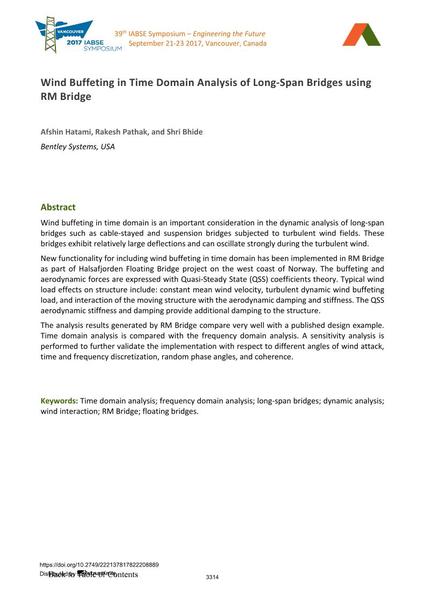Wind Buffeting in Time Domain Analysis of Long-Span Bridges using RM Bridge

|
|
|||||||||||
Détails bibliographiques
| Auteur(s): |
Afshin Hatami
(Bentley Systems, USA)
Rakesh Pathak (Bentley Systems, USA) Shri Bhide (Bentley Systems, USA) |
||||
|---|---|---|---|---|---|
| Médium: | papier de conférence | ||||
| Langue(s): | anglais | ||||
| Conférence: | IABSE Symposium: Engineering the Future, Vancouver, Canada, 21-23 September 2017 | ||||
| Publié dans: | IABSE Symposium Vancouver 2017 | ||||
|
|||||
| Page(s): | 3314-3324 | ||||
| Nombre total de pages (du PDF): | 11 | ||||
| Année: | 2017 | ||||
| DOI: | 10.2749/222137817822208889 | ||||
| Abstrait: |
Wind buffeting in time domain is an important consideration in the dynamic analysis of long-span bridges such as cable-stayed and suspension bridges subjected to turbulent wind fields. These bridges exhibit relatively large deflections and can oscillate strongly during the turbulent wind. New functionality for including wind buffeting in time domain has been implemented in RM Bridge as part of Halsafjorden Floating Bridge project on the west coast of Norway. The buffeting and aerodynamic forces are expressed with Quasi-Steady State (QSS) coefficients theory. Typical wind load effects on structure include: constant mean wind velocity, turbulent dynamic wind buffeting load, and interaction of the moving structure with the aerodynamic damping and stiffness. The QSS aerodynamic stiffness and damping provide additional damping to the structure. The analysis results generated by RM Bridge compare very well with a published design example. Time domain analysis is compared with the frequency domain analysis. A sensitivity analysis is performed to further validate the implementation with respect to different angles of wind attack, time and frequency discretization, random phase angles, and coherence. |
||||
